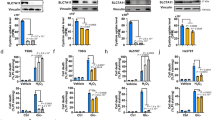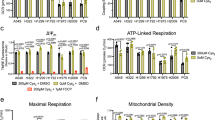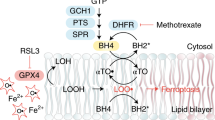Abstract
The glutathione-dependent system is one of the key systems regulating cellular redox balance, and thus cell fate. Cysteine, typically present in its oxidized form cystine in the extracellular space, is regarded as the rate-limiting substrate for glutathione (GSH) synthesis. Cystine is transported into cells by the highly specific amino-acid antiporter system xc−. Since Burkitt's Lymphoma (BL) cells display limited uptake capacity for cystine, and are thus prone to oxidative stress-induced cell death, we stably expressed the substrate-specific subunit of system xc−, xCT, in HH514 BL cells. xCT-overexpressing cells became highly resistant to oxidative stress, particularly upon GSH depletion. Contrary to previous predictions, the increase of intracellular cysteine did not affect the cellular GSH pool, but concomitantly boosted extracellular cysteine concentrations. Even though cells were depleted of bulk GSH, xCT overexpression maintained cellular integrity by protecting against lipid peroxidation, a very early event in cell death progression. Our results show that system xc− protects against oxidative stress not by elevating intracellular GSH levels, but rather creates a reducing extracellular environment by driving a highly efficient cystine/cysteine redox cycle. Our findings show that the cystine/cysteine redox cycle by itself must be viewed as a discrete major regulator of cell survival.
This is a preview of subscription content, access via your institution
Access options
Subscribe to this journal
Receive 50 print issues and online access
$259.00 per year
only $5.18 per issue
Buy this article
- Purchase on SpringerLink
- Instant access to full article PDF
Prices may be subject to local taxes which are calculated during checkout







Similar content being viewed by others
References
Arner ES, Holmgren A . (2000). Physiological functions of thioredoxin and thioredoxin reductase. Eur J Biochem 267: 6102–6109.
Bannai S, Ishii T . (1982). Transport of cystine and cysteine and cell growth in cultured human diploid fibroblasts: effect of glutamate and homocysteate. J Cell Physiol 112: 265–272.
Bannai S, Tateishi N . (1986). Role of membrane transport in metabolism and function of glutathione in mammals. J Membr Biol 89: 1–8.
Bannai S, Sato H, Ishii T, Sugita Y . (1989). Induction of cystine transport activity in human fibroblasts by oxygen. J Biol Chem 264: 18480–18484.
Brielmeier M, Bechet JM, Falk MH, Pawlita M, Polack A, Bornkamm GW . (1998). Improving stable transfection efficiency: antioxidants dramatically improve the outgrowth of clones under dominant marker selection. Nucleic Acids Res 26: 2082–2085.
Broome JD, Jeng MW . (1973). Promotion of replication in lymphoid cells by specific thiols and disulfides in vitro. Effects on mouse lymphoma cells in comparison with splenic lymphocytes. J Exp Med 138: 574–592.
Conrad M, Jakupoglu C, Moreno SG, Lippl S, Banjac A, Schneider M et al. (2004). Essential role for mitochondrial thioredoxin reductase in hematopoiesis, heart development, and heart function. Mol Cell Biol 24: 9414–9423.
Droge W, Eck HP, Gmunder H, Mihm S . (1991). Modulation of lymphocyte functions and immune responses by cysteine and cysteine derivatives. Am J Med 91: 140S–144S.
Ekert PG, Silke J, Vaux DL . (1999). Caspase inhibitors. Cell Death Differ 6: 1081–1086.
Falk MH, Hultner L, Milner A, Gregory CD, Bornkamm GW . (1993). Irradiated fibroblasts protect Burkitt lymphoma cells from apoptosis by a mechanism independent of bcl-2. Int J Cancer 55: 485–491.
Falk MH, Meier T, Issels RD, Brielmeier M, Scheffer B, Bornkamm GW . (1998). Apoptosis in Burkitt lymphoma cells is prevented by promotion of cysteine uptake. Int J Cancer 75: 620–625.
Feussner A, Rolinski B, Weiss N, Deufel T, Wolfram G, Roscher AA . (1997). Determination of total homocysteine in human plasma by isocratic high-performance liquid chromatography. Eur J Clin Chem Clin Biochem 35: 687–691.
Gillissen B, Essmann F, Graupner V, Starck L, Radetzki S, Dorken B et al. (2003). Induction of cell death by the BH3-only Bcl-2 homolog Nbk/Bik is mediated by an entirely Bax-dependent mitochondrial pathway. EMBO J 22: 3580–3590.
Griffith OW . (1982). Mechanism of action, metabolism, and toxicity of buthionine sulfoximine and its higher homologs, potent inhibitors of glutathione synthesis. J Biol Chem 257: 13704–13712.
Hattori H, Imai H, Furuhama K, Sato O, Nakagawa Y . (2005). Induction of phospholipid hydroperoxide glutathione peroxidase in human polymorphonuclear neutrophils and HL60 cells stimulated with TNF-alpha. Biochem Biophys Res Commun 337: 464–473.
Ishii T, Sugita Y, Bannai S . (1987). Regulation of glutathione levels in mouse spleen lymphocytes by transport of cysteine. J Cell Physiol 133: 330–336.
Jakupoglu C, Przemeck GK, Schneider M, Moreno SG, Mayr N, Hatzopoulos AK et al. (2005). Cytoplasmic thioredoxin reductase is essential for embryogenesis but dispensable for cardiac development. Mol Cell Biol 25: 1980–1988.
Jonas CR, Ziegler TR, Gu LH, Jones DP . (2002). Extracellular thiol/disulfide redox state affects proliferation rate in a human colon carcinoma (Caco2) cell line. Free Radic Biol Med 33: 1499–1506.
Kuppner MC, Scharner A, Milani V, Von Hesler C, Tschop KE, Heinz O et al. (2003). Ifosfamide impairs the allostimulatory capacity of human dendritic cells by intracellular glutathione depletion. Blood 102: 3668–3674.
Meister A . (1995). Glutathione metabolism. Methods Enzymol 251: 3–7.
Melino G . (2005). Discovery of the ubiquitin proteasome system and its involvement in apoptosis. Cell Death Differ 12: 1155–1157.
Metcalf D . (1976). Role of mercaptoethanol and endotoxin in stimulating B lymphocyte colony formation in vitro. J Immunol 116: 635–638.
Murphy TH, Miyamoto M, Sastre A, Schnaar RL, Coyle JT . (1989). Glutamate toxicity in a neuronal cell line involves inhibition of cystine transport leading to oxidative stress. Neuron 2: 1547–1558.
Murphy TH, Schnaar RL, Coyle JT . (1990). Immature cortical neurons are uniquely sensitive to glutamate toxicity by inhibition of cystine uptake. FASEB J 4: 1624–1633.
Nicotera P, Melino G . (2004). Regulation of the apoptosis-necrosis switch. Oncogene 23: 2757–2765.
Niwa H, Masui S, Chambers I, Smith AG, Miyazaki J . (2002). Phenotypic complementation establishes requirements for specific POU domain and generic transactivation function of Oct-3/4 in embryonic stem cells. Mol Cell Biol 22: 1526–1536.
Nonn L, Williams RR, Erickson RP, Powis G . (2003). The absence of mitochondrial thioredoxin 2 causes massive apoptosis, exencephaly, and early embryonic lethality in homozygous mice. Mol Cell Biol 23: 916–922.
Novogrodsky A, Nehring Jr RE, Meister A . (1979). Inhibition of amino acid transport into lymphoid cells by the glutamine analog L-2-amino-4-oxo-5-chloropentanoate. Proc Natl Acad Sci USA 76: 4932–4935.
Okita C, Sato M, Schroeder T . (2004). Generation of optimized yellow and red fluorescent proteins with distinct subcellular localization. Biotechniques 36: 418–422, 424.
Okuno S, Sato H, Kuriyama-Matsumura K, Tamba M, Wang H, Sohda S et al. (2003). Role of cystine transport in intracellular glutathione level and cisplatin resistance in human ovarian cancer cell lines. Br J Cancer 88: 951–956.
Peterson JD, Herzenberg LA, Vasquez K, Waltenbaugh C . (1998). Glutathione levels in antigen-presenting cells modulate Th1 versus Th2 response patterns. Proc Natl Acad Sci USA 95: 3071–3076.
Sato H, Fujiwara K, Sagara J, Bannai S . (1995). Induction of cystine transport activity in mouse peritoneal macrophages by bacterial lipopolysaccharide. Biochem J 310: 547–551.
Sato H, Shiiya A, Kimata M, Maebara K, Tamba M, Sakakura Y et al. (2005). Redox imbalance in cystine/glutamate transporter-deficient mice. J Biol Chem 280: 37423–37429.
Sato H, Tamba M, Ishii T, Bannai S . (1999). Cloning and expression of a plasma membrane cystine/glutamate exchange transporter composed of two distinct proteins. J Biol Chem 274: 11455–11458.
Shi ZZ, Osei-Frimpong J, Kala G, Kala SV, Barrios RJ, Habib GM et al. (2000). Glutathione synthesis is essential for mouse development but not for cell growth in culture. Proc Natl Acad Sci USA 97: 5101–5106.
Sipos K, Lange H, Fekete Z, Ullmann P, Lill R, Kispal G . (2002). Maturation of cytosolic iron–sulfur proteins requires glutathione. J Biol Chem 277: 26944–26949.
Sonoda Y, Aiba N, Utsubo R, Koguchi E, Hasegawa M, Kasahara T . (2004). Induction of antioxidant enzymes by FAK in a human leukemic cell line, HL-60. Biochim Biophys Acta 1683: 22–32.
Tietze F . (1969). Enzymic method for quantitative determination of nanogram amounts of total and oxidized glutathione: applications to mammalian blood and other tissues. Anal Biochem 27: 502–522.
Verrey F, Meier C, Rossier G, Kuhn LC . (2000). Glycoprotein-associated amino acid exchangers: broadening the range of transport specificity. Pflugers Arch 440: 503–512.
von Haefen C, Gillissen B, Hemmati PG, Wendt J, Guner D, Mrozek A et al. (2004). Multidomain Bcl-2 homolog Bax but not Bak mediates synergistic induction of apoptosis by TRAIL and 5-FU through the mitochondrial apoptosis pathway. Oncogene 23: 8320–8332.
Wieder T, Essmann F, Prokop A, Schmelz K, Schulze-Osthoff K, Beyaert R et al. (2001). Activation of caspase-8 in drug-induced apoptosis of B-lymphoid cells is independent of CD95/Fas receptor-ligand interaction and occurs downstream of caspase-3. Blood 97: 1378–1387.
Ye ZC, Sontheimer H . (1999). Glioma cells release excitotoxic concentrations of glutamate. Cancer Res 59: 4383–4391.
Acknowledgements
We thank A Richter for expert technical assistance, A Klöpfer for technical advice and J-M Bechét for critical reading of the manuscript. We are grateful to T Schroeder for the p141CAG-3SIP vector, W Droege and A Roscher for helpful discussions. This work was supported by a grant of Deutsche Forschungsgemeinschaft (Priority Programme ‘Biology of Selenoproteins’) to GWB and MC, by a short-term fellowship of Deutsche Akademische Austauschdienst (DAAD), and Japanese Society for Promotion of Science (JSPS) to HS and MC for working in Munich and in Tsuruoka, respectively. GWB was additionally supported by Fonds der Chemischen Industrie.
Author information
Authors and Affiliations
Corresponding author
Additional information
Supplementary Information accompanies the paper on the Oncogene website (http://www.nature.com/onc).
Rights and permissions
About this article
Cite this article
Banjac, A., Perisic, T., Sato, H. et al. The cystine/cysteine cycle: a redox cycle regulating susceptibility versus resistance to cell death. Oncogene 27, 1618–1628 (2008). https://doi.org/10.1038/sj.onc.1210796
Received:
Revised:
Accepted:
Published:
Issue Date:
DOI: https://doi.org/10.1038/sj.onc.1210796
Keywords
This article is cited by
-
Selenium reduction of ubiquinone via SQOR suppresses ferroptosis
Nature Metabolism (2024)
-
NMDARs activation regulates endothelial ferroptosis via the PP2A-AMPK-HMGB1 axis
Cell Death Discovery (2024)
-
Plasma metabolites in childhood Burkitt lymphoma cases and cancer-free controls in Uganda
Metabolomics (2024)
-
LncFASA promotes cancer ferroptosis via modulating PRDX1 phase separation
Science China Life Sciences (2024)
-
Hydropersulfides inhibit lipid peroxidation and ferroptosis by scavenging radicals
Nature Chemical Biology (2023)



